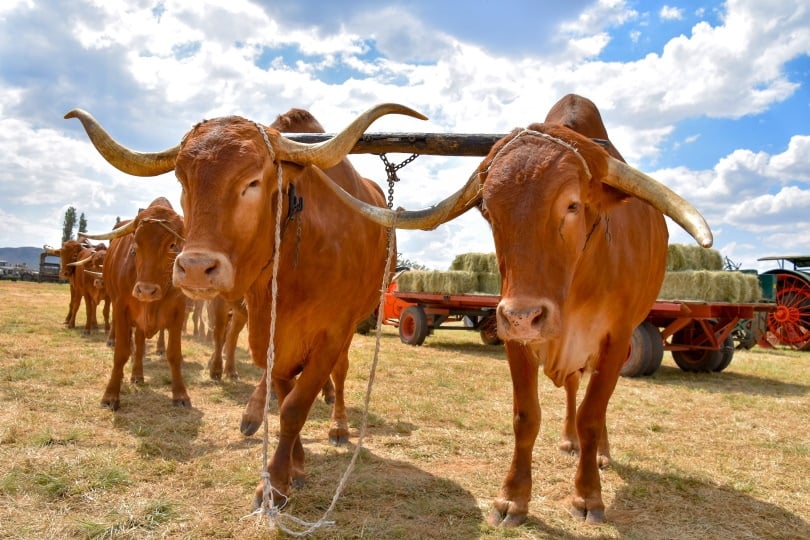Africander cattle (also known as Afrikaner cattle) originated in South Africa. The Africander is also considered a Sanga cattle breed, which is a collective name for all indigenous cattle of sub-Saharan Africa.
The Africander cattle were bred primarily for their meat and are considered South Africa’s most popular indigenous breed of cattle.
Here, we look at a few interesting facts and characteristics of Africander cattle.

Quick Facts About the Africander Cattle
| Breed Name: | Africander or Afrikaner |
| Place of Origin: | South Africa |
| Uses: | Meat |
| Bull (Male) Size: | 820–1,090 kg (1,808–2,403 lbs.) |
| Cow (Female) Size: | 450–600 kg (992–1,323 lbs.) |
| Color: | Light tan to deep red |
| Lifespan: | 16+ years |
| Climate Tolerance: | Native climate (hot and dry) |
| Care Level: | Relatively easy |
| Production: | Good for meat production |
| Fertility: | Good |
Africander Cattle Origins
Africander cattle were originally developed from the cattle of the Khoikhoi people of the Cape of Good Hope and are thought to have Zebu and Egyptian longhorn ancestors.
When the Dutch started to settle South Africa, they used the Africander as draft animals for the Great Trek of 1835–1846.
They were introduced to the U.S. in 1923, which then imported the Africander to Australia in the early 1950s.
In 1912, the first studbook for the Africander was formed to help control its development into the cattle that we are familiar with today.

Africander Catttle Characteristics
The Africander shows good resistance to heat, typically hot and arid conditions, due in part that it has twice as many pores for sweating as European cattle. The Africander has thick skin but a short coat, which helps it cope with excessive heat.
This breed has also proven to be resistant to diseases spread by ticks. They are considered economical cattle because a large number of Africander cattle can be kept together on the same land as other breeds.
The Africander is also easy to handle and generally has an excellent temperament. It’s quite hardy and can prove resilient to drought conditions through eating leaves and grass.
The cows make great mothers — they take good care of their calves and have excellent milk production. They also easily calve and typically have low mortality rates. One cow can calve as many as 10 or more calves in her lifetime.
This cattle breed is also quite capable of crossbreeding successfully with other beef cattle breeds.
Africanders are strong walkers, which enables them to walk on sandy and mountainous terrain. They are quite well adapted to living in harsh environments.
Africander Cattle Uses
When the Africander was being used by the Khoikhoi, it was primarily for its meat and milk. However, the main use of the Africander today is for meat production. It is known for its lean and tender marbled meat.
Africander Cattle Appearance & Varieties
The Africander is a medium to large breed that is strongly muscled with long legs and a medium-sized frame. It has the distinctive cervicothoracic hump on the back of its neck that is commonly seen on Sanga cattle (and their Zebu ancestors).
These cattles’ coats are short and glossy and range from a lighter reddish tan to a deep red color. Their skin tends to be loose, and their ears droop rather than being held erect.
Both cows and bulls have horns, which are long and run horizontally and turn upward at the tips. The horns are white or off-white with amber tips, but there are also polled Africanders (polled essentially means livestock that are bred without horns).
Cows are considerably smaller than bulls — even the largest cow is smaller than the smallest bull.
Africander Cattle Distribution
Africander cattle do quite well with consuming feed. For example, you can have 100 Africander cows and their calves on the same land that would typically only support 80 cows of a different breed.
They do well in harsh conditions and in droughts and can be crossbred quite successfully. They are also capable of walking up mountainous terrain and on sandy ground, so large herds of Africanders are quite manageable.
See Also:

Are Africanders Good for Small-Scale Farming?
Africander cattle can just as easily be kept in small herds as in large herds. Their temperament means they are easy to look after, and they are not an overall high-maintenance breed.
The fact that they can be crossbred with other cattle breeds means you can keep them with these other breeds too. Their resistance to ticks and other insect-borne diseases adds to the Africander being easy to look after.
Africanders are popular indigenous cattle to South Africa that have proven hardy and easy to take care of. They’re perfect for farms of any size.
Featured Image Credit: Wandel Guides, Shutterstock
